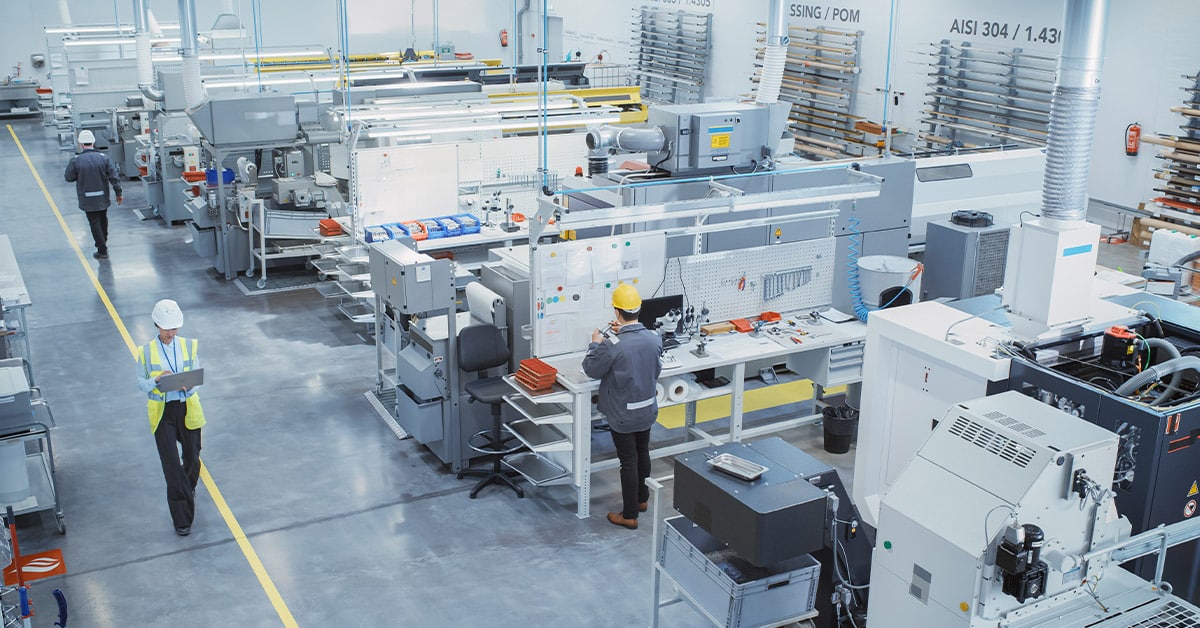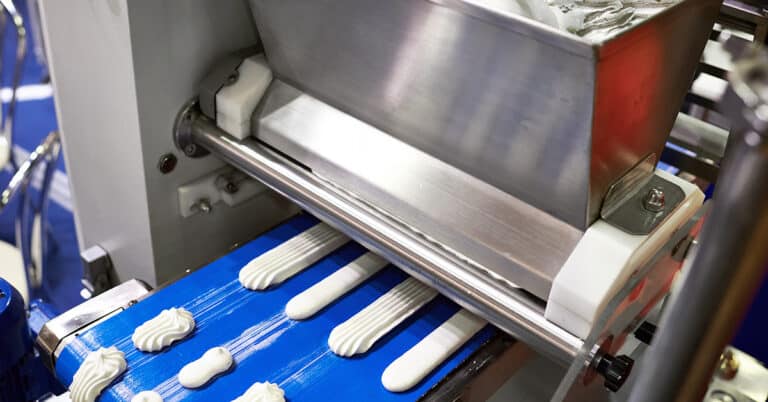The fishbone diagram is a simple yet powerful tool for determining the root cause of problems like breakdowns and scrap parts. It’s an essential tool for continuous improvement in Lean and Six Sigma environments and is equally valuable wherever there’s a need for root cause analysis.
This blog provides a guide to using the fishbone diagram in manufacturing. It explores how to create a fishbone diagram and how the fishbone fits within Lean manufacturing. On completion, readers should have enough knowledge to launch their own fishbone-based problem-solving exercise.
Introduction to fishbone diagrams in manufacturing
The fishbone diagram is so-called because it looks like the skeleton of a fish. There’s a central spine — the problem being addressed — and bones feeding into the spine that represent classes or types of possible cause.
These bones are labeled as: Man, Method, Machine, Material, Measurement and Medium (or Mother Nature — the environment). Collectively, they are known as the 6Ms of manufacturing.
The fishbone diagram is also known as the Ishikawa diagram, named for its inventor, Kaora Ishikawa. Ishikawa was an engineer and professor who worked on quality improvement techniques. He created the diagram as a tool to help project management teams establish the root causes of specific manufacturing problems, which leads to its other name: the cause and effect diagram.
Fishbone diagrams are used for root cause failure analysis. They help teams brainstorm potential reasons for failures in processes or equipment and to come up with actions to prevent the problem recurring. The fishbone diagram is related to the “mind map” used for organizing information in a visual manner.
Two types of manufacturing problems suitable for the fishbone analysis tool are:
- Continuous improvement efforts: Reducing waste in a process by brainstorming potential causes, then conducting kaizen exercises on the primary candidates.
- Machine breakdowns: Determining the root causes of repeated breakdowns so corrective actions and appropriate preventive maintenance can be implemented.
Step-by-step guide to creating a fishbone diagram
The activity requires a small team, a whiteboard or flipchart and a stack of sticky notes. The steps the team should follow are:
- Define the problem: Draw a spine, (a horizontal line), and place an unambiguous problem statement to the right of where it ends. For example, this might be “Fuse keeps blowing on circuit 27.” (A fishbone diagram template may be useful, but only if the team is able to gather around it in a way that supports discussion.)
- Draw bones feeding in to the spine: These usually cover the 6Ms and are labeled: Materials, Methods, Machines, Manpower, Measurement and Medium (Environment). In some cases, a team might want to assign other, perhaps more specific, types or classes of cause.
- For each M, brainstorm possible causes: Either write on sticky notes and place them on the appropriate bone, or write the words directly on the diagram. (Using sticky notes allows debate about where each possible cause should be assigned.)
An absence of sticky notes on any bone should motivate the team to explore how that M might contribute to the problem.
- Review each of the ideas captured on the diagram. This is often done using the “5 Whys” technique. This entails, for each possible cause, asking why it might be a reason. Each answer is followed by another “why?”. It’s a process sometimes likened to peeling an onion, that usually gets to the root of the problem.
- Disregard implausible or highly unlikely causes.
- Collect data on plausible causes. Let this guide the team in whether to pursue the idea further.
On completion, the team should have reached agreement about the most likely causes of the problem they were studying. In most cases, they also know the actions needed to bring about a permanent resolution.
Integrating fishbone diagrams into problem-solving processes
Not every problem encountered in manufacturing needs fishbone analysis. It’s a tool that takes time to deploy and reap results, so it should be reserved for when a team tasked with solving a problem has trouble finding the root cause.
Successful use requires:
- A problem that can be stated clearly and concisely
- A leader or facilitator who understands how to use the fishbone diagram technique
- Team members willing to offer up ideas that may at first seem a little “off the wall”
- An openness to ideas and a willingness to gather data to support or disprove them
The fishbone technique can encounter resistance, especially from more seasoned team members. This is because it takes time to use, and the team can be sidetracked by discussion of highly implausible causes.
There can also be a tendency to jump to the “obvious” cause before all possible contributing factors have been considered. (The purpose of the exercise is to avoid such jumping to conclusions.)
Avoiding or resolving such problems requires the leader to foster a collaborative, judgment-free culture where product management team members can offer ideas and ask questions without fear of ridicule.
Exploring lean manufacturing and continuous improvement
Most manufacturers operate in globally competitive markets, and the only way to survive is by continually seeking out ways to improve operational efficiency. This comes primarily from raising equipment utilization and availability (higher OEE) and reducing waste.
OEE goals are often tackled through the 8 pillars of Total Productive Maintenance (TPM) and by designing equipment on Reliability, Availability, and Maintainability (RAM) principles. Waste is addressed mostly through Lean manufacturing techniques, sometimes in conjunction with Six Sigma (an approach to variation reduction sometimes wrapped up as Lean Six Sigma), or Zero Defect Manufacturing.
What these have in common is an emphasis on continuous improvement, which is where the fishbone Ishikawa fishbone diagram comes in. The fishbone technique engages employees in problem-solving efforts related directly to their work. Most employees have had the experience of struggling with recurring problems that, while perhaps small and quickly resolved, are disruptive and morale-sapping. They are also wasteful of time and materials.
When a problem is well understood, a team tasked with continuous improvement (or kaizen as it’s referred to in Lean), can work together to implement a solution. However, this requires the cause to be clear, and often it isn’t.
The fishbone technique therefore complements and supports efforts to reduce waste and improve machine reliability and availability. By engaging team members in determining root causes, it taps into their process and equipment knowledge, at the same time involving them in activities that will resolve some of the problems they face every day.
Advanced techniques and tools for fishbone diagrams
As teams become comfortable performing fishbone analyses, they often start taking the idea further. This can be allowed to happen organically or can be encouraged by a team leader familiar with more advanced techniques and tools. In addition, a variety of software tools and apps are available to support more advanced fishbone diagramming.
The enhancements most often adopted or applied are:
- Add quantification to each possible cause
- Apply Pareto analysis (the 80-20 rule) to determine the most significant causes
- Create additional layers of branching
- Combine with the mind map technique to identify and group causes by theme
Experienced practitioners may also be interested in reverse fishbone diagrams. Here the problem statement is replaced with a goal, such as “zero defects,” and the branches are used to identify actions needed to achieve it.
Support for maintenance optimization
The fishbone, or Ishikawa diagram, doesn’t solve manufacturing problems, it helps teams determine what has caused a problem. In this sense, it provides the point from which problem-solving can begin.
Using fishbone diagrams to go from effect to cause helps solve problems such as high scrap rates and microstoppages in production. For maintenance teams trying to boost OEE, fishboning is valued for its ability to help identify preventive maintenance actions that solve persistent problems.
Preventive maintenance is essential for manufacturers and project managers seeking to strengthen their competitive position. Implementation can be challenging though, particularly when corrective repairs must take priority over longer-term planned maintenance. ATS helps manufacturers through this with a full range of preventive maintenance services. Contact us for more information.






